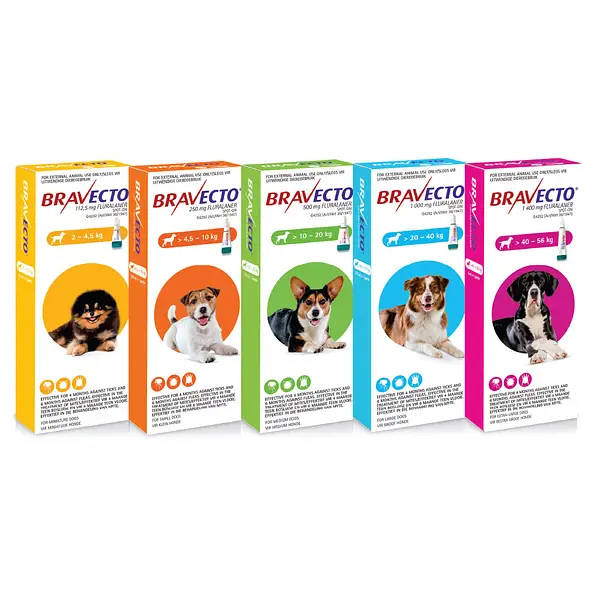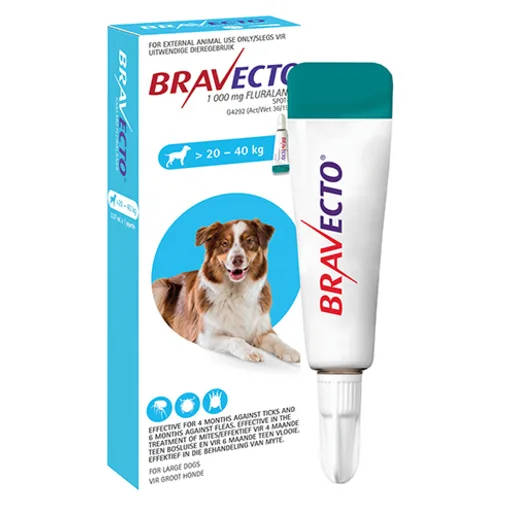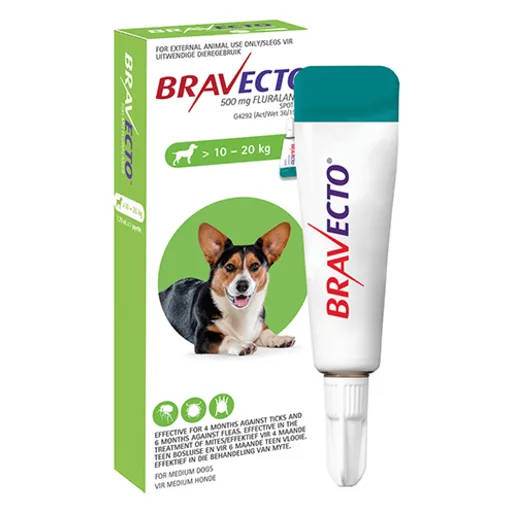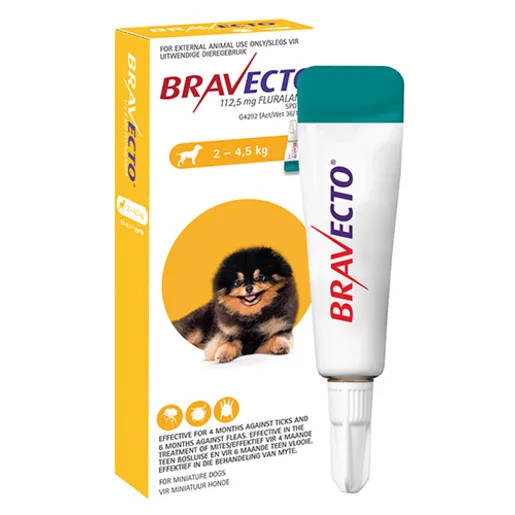










Bravecto Spot On Dogs
Check my rate
View locations
| Main centres: | 1-3 business days |
| Regional areas: | 3-4 business days |
| Remote areas: | 3-5 business days |











| Main centres: | 1-3 business days |
| Regional areas: | 3-4 business days |
| Remote areas: | 3-5 business days |
For the treatment and prevention of tick, flea and mite infestations in dogs and cats.
Bravecto® Spot-On can be used as part of a treatment strategy for Flea Allergy Dermatitis (FAD). For the treatment of mange caused by Demodex spp. and Sarcoptes scabiei mites in dogs. For the treatment of Otodectes spp. mite infestations in dogs and cats.
In cats, Bravecto® Spot-On provides immediate and persistent flea and tick killing activity for 3 months.
In dogs, Bravecto® Spot-On provides immediate and persistent tick killing activity for 4 months and flea killing activity for 6 months. Bravecto® Spot-On is well tolerated in MDR1 dogs.
A single treatment prevents Dipylidium caninum transmission from infected fleas to susceptible dogs for 12 weeks.
COMPOSITION
Each 1 m of Bravecto® Spot-On contains 280 mg fluralaner.
Each pipette delivers:
| Miniature dogs: | 112,5 mg fluralaner | Small cats: | 112,5 mg fluralaner |
| Small dogs: | 250 mg fluralaner | Medium cats: | 250 mg fluralaner |
| Medium dogs: | 500 mg fluralaner | Large cats: | 500 mg fluralaner |
| Large dogs: | 1 000 mg fluralaner | ||
| Extra-large dogs: | 1 400 mg fluralaner |
CLINICAL PHARMACOLOGY
Peak fluralaner concentrations are achieved between 7 and 42 days following topical administration and the elimination half-life ranges between 14 and 29 days. The bioavailability of fluralaner following oral and topical administration is approximately 25 %.
PHARMACODYNAMIC PROPERTIES
Fluralaner is an acaricide and insecticide. It is efficacious against ticks, fleas and mites.
Fluralaner is for systemic use and belongs to the class of isoxazoline-substituted benzamide derivatives.
Fluralaner is an inhibitor of parts of the arthropod nervous system. The mode of action of fluralaner is the antagonism of the ligand-gated chloride channels (gamma-aminobutyric acid (GABA)-receptor and glutamate-receptor).
CAUTION
STORAGE INSTRUCTIONS
WARNINGS
PRECAUTIONS
INTERACTIONS
Fluralaner is highly bound to plasma proteins and might compete with other highly bound drugs such as non-steroidal anti-inflammatory drugs (NSAIDs) and the coumarin derivative warfarin. Incubation of fluralaner in the presence of carprofen or warfarin in dog plasma at maximum expected plasma concentrations did not reduce the protein binding of fluralaner, carprofen or warfarin.
During laboratory and clinical field testing, no interactions between Bravecto® Spot-On and routinely used veterinary medicinal products were observed.
ADVERSE REACTIONS
Commonly observed adverse reactions in clinical trials were mild and transient skin reactions at the application site (1,2 % of treated dogs and 2,2 % of treated cats).
Cat's skin reactions were such as erythema and pruritus (most likely due to a transient discomfort) or alopecia (secondary effect due to scratching or licking). As a result of transient discomfort shortly after administration, the following signs were observed: apathy/tremors/anorexia (0,9 % of treated cats) or vomiting/hypersalivation (0,4 % of treated cats). Based on post-registration experience, convulsions have very rarely been reported, (less than 1 in 10 000 animals treated).
Emesis, lethargy, inappetence, muscle tremors, ataxia and convulsions have been reported very rarely in spontaneous reports after the use of this product (less than 1 animal in 10 000 animals treated).
If you notice any serious effects or other effects not mentioned in this package leaflet, please inform your veterinarian.
DIRECTIONS FOR U...